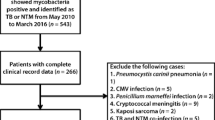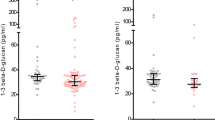Summary
The great majority of individuals with human immunodeficiency virus type 1 (HIV-1) infection presents with no signs or symptoms, or only lymphadenopathy. To initiate prophylactic measures in time it is necessary to establish risk criteria. CD4+ cell counts are significant predictors. Supplementary methods to improve the predictive information of CD4+ cell counts are still required. In addition, CD4+ cell counting is laborious, expensive, and restricted to specialized laboratories. Thus, there is also a place for more easily performed laboratory tests with similar predictive value as CD4+ cell counts. Neopterin and β2-microglobulin levels proved to be significant predictors of AIDS risk in HIV-1 seropositives. The predictive value of both parameters is equal to CD4+ cell counts and both markers are significant joint predictors in addition to CD4+ cell counts. Measurement of the parameters is done in serum (neopterin and β2-microglobulin) or urine (neopterin) specimens which reduces the risk of HIV-1 transmission compared to handling of whole-blood samples as it is required for cell counting. Although more studies are needed, especially in developing countries and in persons receiving zidovudine, it can be recommended to use neopterin and β2-microglobulin as additional marker to estimate AIDS risk in HIV-1 seropositive individuals. Moreover, both markers may be useful for this purpose without CD4+ cell counts if cell counting is not available.
Zusammenfassung
Die Mehrheit der mit dem humanen Immundefizienzvirus Typ 1 (HIV-1) infizierten Personen ist frei von Symptomen oder weist nur persistierende Lymphadenopathie auf. Es ist notwendig, Risikokriterien für das Fortschreiten der Erkrankung zu erstellen, um zeitgerecht prophylaktische Maßnahmen einleiten zu können. Die Zahl der CD4-positiven Zellen ist ein geeigneter Prognoseparameter. Die Zellzählung ist jedoch aufwendig, teuer und Speziallabors vorbehalten, sodaß zusätzliche einfache Untersuchungen erwünscht sind, um die Risikoabschätzung weiter zu verbessern. Wissenschaftliche Untersuchungen ergaben, daß Neopterin und ß2- Mikroglobulin bei der HIV-1 Infektion gleich gute Prognoseparameter sind wie die Zahl der CD4-positiven Zellen; beide Parameter liefern darüber hinaus zusätzliche Infromation. Die Bestimmung der Meßgrößen erfolgt aus Serum (Neopterin und ß2-Mikroglobulin) oder Urin (Neopterin), wodurch das Risiko einer eventuellen HIV-1 Übertragung bei der Testdurchführung im Vergleich zur Bearbeitung von Vollblut, wie es zur Zellzählung benötigt wird, verringert wird. Auch wenn noch weitere Untersuchungen vor allem in Entwicklungsländern und in mit Zidovudin behandelten HIV-1 Infizierten notwendig sind, können Neopterin und β2-Mikroglobulin als zusätzliche Parameter zur Abschätzung des AIDS-Risikos bei HIV-1 Infizierten empfohlen werden. Beide Meßgrößen sind auch dazu geeignet, die Bestimmung von CD4- positiven Zellen zu ersetzen, wenn die Möglichkeiten der Zellquantifizierung nicht gegeben sind.
Similar content being viewed by others
References
Goedert, J. J., Biggar, R. J., Weiss, S. H., Eyster, M. E., Melbye, M., Wilson, S., Ginzburg, H. M., Grossman, R. J., DiGioia, R. A., Sanchez, W. C., Giron, J. A., Ebbesen, P., Gallo, R. C., Blattner, W. A. Three-year incidence of AIDS in five cohorts of HTLV-III-infected risk group members. Science 231 (1986) 992–996.
Melbye, M., Biggar, R. J., Ebbesen, O., Neuland, C., Goedert, J. J., Faber, V., Lorenzen, I., Skinhoj, P., Gallo, R. C., Blattner, W. A. Long term seropositivity for human T-lymphotropic virus type III in homosexual men without the acquired immunodeficiency syndrome: development of immunological and clinical abnormalities. Ann. Intern. Med. 104 (1986) 496–500.
Polk, B. F., Fox, R., Brookmeyer, R., Kanchanaraska, S., Kaslow, R., Visscher, B., Rinaldo, C., Phair, J. Predictors of the acquired immunodeficiency syndrome developing in a cohort of seropositive homosexual men. N. Engl. J. Med. 316 (1987) 61–66.
Goedert, J. J., Biggar, B. J., Melbye, M., Mann, D. L., Wilson, S., Gail, M. H., Grossmann, R. J., DiGioia, R. A., Sanchez, W. C., Weiss, S. H., Blattner, W. A. Effect of T4 count and cofactors on AIDS incidence in homosexual men infected with human immunodeficiency virus. J. Am. Med. Assoc. 257 (1987) 331–333.
Wachter, H., Fuchs, D., Hausen, A., Reibnegger, G., Werner, E. R. Neopterin as a marker for activation of cellular immunity: immunological basis and clinical application. Adv. Clin. Chem. 27 (1989) 81–141.
Fuchs, D., Hausen, A., Reibnegger, G., Werner, E. R., Dierich, M. P., Wachter, H. Neopterin as a marker for activated cell-mediated immunity: application in HIV-infection. Immunol. Today 9 (1988) 150–155.
Dargemont, C., Dunon, D., Deugnier, M. A., Denoyelle, M., Girault, J. M., Lederer, F., Le K. H. D., Godeau, F., Thiery, J. P., Imhof, B. A. Thymotaxin, a chemotactic protein, is identical to β2- microglobulin. Science 246 (1989) 803–805.
Child, J. A., Kushawa, R. S. Serum beta2-microglobulin in lymphoproliferative and myeloproliferative diseases. Hematol. Oncol. 2 (1984) 391–401.
Bernier, G. M., Fanger, M. W. Synthesis of β2- microglobulin by stimulated lymphocytes. J. Immunol. 109 (1972) 407–409.
Fuchs, D., Hausen, A., Reibnegger, G., Werner, E. R., Werner-Felmayer, G., Wachter, H. β2-Microglobulin and immune activation. Clin. Chem. 35 (1989) 2158.
Wachter, H., Fuchs, D., Hausen, A., Huber, C., Knosp, O., Reibnegger, G., Spira, T. J. Elevated urinary neopterin levels in patients with the acquired immunodeficiency syndrome (AIDS). Hoppe Seyler's Z. Physiol. Chem. 364 (1983) 1345–1346.
Fuchs, D., Reibnegger, G., Wachter, H., Jaeger, H., Popescu, M., Kaboth, W. Neopterin levels correlating with the Walter Reed Staging Classification in human immunodeficiency virus (HIV) infection. Ann. Intern. Med. 107 (1987) 784–785.
Fuchs, D., Banekovich, M., Hausen, A., Hutterer, J., Reibnegger, G., Werner, E. R., Gschnait, F. D., Dierich, M. P., Wachter, H. Neopterin estimation compared with the ratio of T-cell subpopulations in persons infected with human immunodeficiency virus 1. Clin. Chem. 34 (1988) 2415–2417.
Wachter, H., Fuchs, D., Hausen, A., Reibnegger, G., Werner, E. R., Dierich, M. P. Neopterin bei Infektionen mit dem humanen Immunmangelvirus (HIV). Deutsch. Med. Wochenschr. 113 (1988) 1890–1897.
Melmed, R. N., Taylor, J. M. G., Detels, R., Bozorghmeri, M., Fahey, J. L. Serum neopterin changes in HIV infected subjects: indicator of significant pathology, CD4 T cell changes, and the development of AIDS. J. Acquir. Immune Defic. Syndr. 2 (1989) 70–76.
Krämer, A., Wiktor, S. Z., Fuchs, D., Milstien, S., Gail, M. H., Yellin, F. J., Biggar, R. J., Wachter, H., Kaufman, S., Blattner, W. A., Goedert, J. J. Neopterin: a predictive marker of acquired immune deficiency syndrome in human immunodeficiency virus infection. J. Acquir. Immune Defic. Syndr. 2 (1989) 291–296.
Fuchs, D., Spira, T. J., Hausen, A., Reibnegger, G., Werner, E. R., Werner-Felmayer, G., Wachter, H. Neopterin as a predictive marker for disease progression in human immunodeficiency virus type 1 infection. Clin. Chem. 35 (1989) 1746–1749.
Bogner, J. R., Matuschke, A., Heinrich, B., Eberle, E., Goebel, F. D. Serum neopterin levels as predictors of AIDS. Klin. Wochenschr. 66 (1988) 1015–1018.
Fahey, J. L., Taylor, J. M. G., Detels, R., Hofmann, B., Melmed, R., Nishanian, P., Giorgi, J. V. The prognostic value of cellular and serological markers in infection with human immunodeficiency virus type 1. N. Engl. J. Med. 322 (1990) 166–172.
Krämer, A., Biggar, R. J., Fuchs, D., Rosenberg, P. S., Gail, M. H., Yellin, F. Y., Wachter, H., Goedert, J. J. Levels of CD4 + lymphocytes, neopterin, and β2-microglobulin are early predictors of acquired immunodeficiency syndrome. In:Khan, N., Melnick, J. L. (eds.): Monographs in virology. Karger, Basel, Switzerland, 18 (1990) 61–73.
Fuchs, D., Jäger, H., Popescu, M., Reibnegger, G., Werner, E. R., Dierich, M. P., Kaboth, W., Tilz, G. P., Wachter, H. Immune activation markers to predict AIDS and survival in HIV-1 seropositives. Immunol. Letters 26 (1990) 79–84.
Bhalla, R. B., Safai, B., Mertelsmann, R., Schwartz, M. K. Abnormally high concentrations of β2-microglobulin in acquired immunodeficiency syndrome (AIDS) patients. Clin. Chem. 29 (1983) 1560.
Zolla-Pazner, S., William, D., El-Sadr, W., Marmor, M., Stahl, R. Quantitation of beta2-microglobulin and other immune characteristics in a prospective study of men at risk for acquired immune deficiency syndrome. J. Am. Med. Assoc. 251 (1984) 2951–2955.
Kofler, H., Fuchs, D., Hintner, H., Wachter, H. Fritsch, P. Urinary neopterin: an early marker of HIV infection. Eur. J. Clin. Microbiol. 6 (1987) 698–699.
Hofmann, B., Wang, Y., Cumberland, W. G., Detels, R., Bozorgmehri, M., Fahey, J. L. Serum beta2-microglobulin levels increases in HIV- infection: relation to seroconversion, CD4 T-cell fall and progrnosis. AIDS 4 (1990) 207–214.
Moss, A. R., Bacchetti, P., Osmond, D., Krampf, W., Chaisson, R. E., Stites, D. P., Wilber, J., Allain, J. P., Carlson, J. Seropositivity for HIV and the development of AIDS or AIDS related condition: three year follow-up of the San Francisco General Hospital cohort. Brit. Med. J. 296 (1988) 745–750.
Jacobson, M. A., Abrams, D. I., Volberding, P. A., Bacchetti, P., Wilber, J., Chaisson, R. E., Crowe, S., Howard, W., Moss, A. Serum β2-microglobulin decreases in patients with AIDS or ARC treated with azidothymidine. J. Infect. Dis. 159 (1989) 1029–1036.
Crocchiolo, P., Arcidiacano, I., Lizioli, A., Bedarida, G., Cambie, G., Nardella, M., Berto, E.: Role of serum neopterin level in the follow-up of AZT-treated patients with HIV infection. 6th International Conference on AIDS, Stockholm 1988, Abstract 3645.
Hutterer, J., Fuchs, D., Wallner, N., Vetter, N., Wachter, H.: Neopterin changes during zidovudine treatment of HIV-1 infection. Pteridines, in press.
Krämer, A., Biggar, R. J., Goedert, J. J. Markers of risk in HIV-1. N. Engl. J. Med. 322 (1990) 1886.
Fuchs, D., Albert, J., Asjoe, B., Fenyoe, E. M., Reibnegger, G., Wachter, H. Association between serum neopterin concentrations andin vitro replicative capacity of HIV-1 isolates. J. Infect. Dis. 160 (1989) 724–725.
Fuchs, D., Hausen, A., Reibnegger, G., Werner, E. R., Werner-Felmayer, G., Dierich, M. P., Wachter, H. Interferon-gamma concentrations are increased in sera from individuals infected with human immunodeficiency virus type 1. J. Acquir. Immune Defic. Syndr. 2 (1989) 158–162.
Author information
Authors and Affiliations
Rights and permissions
About this article
Cite this article
Fuchs, D., Krämer, A., Reibnegger, G. et al. Neopterin and β2-microglobulin as prognostic indices in human immunodeficiency virus type 1 infection. Infection 19 (Suppl 2), S98–S102 (1991). https://doi.org/10.1007/BF01644476
Issue Date:
DOI: https://doi.org/10.1007/BF01644476




